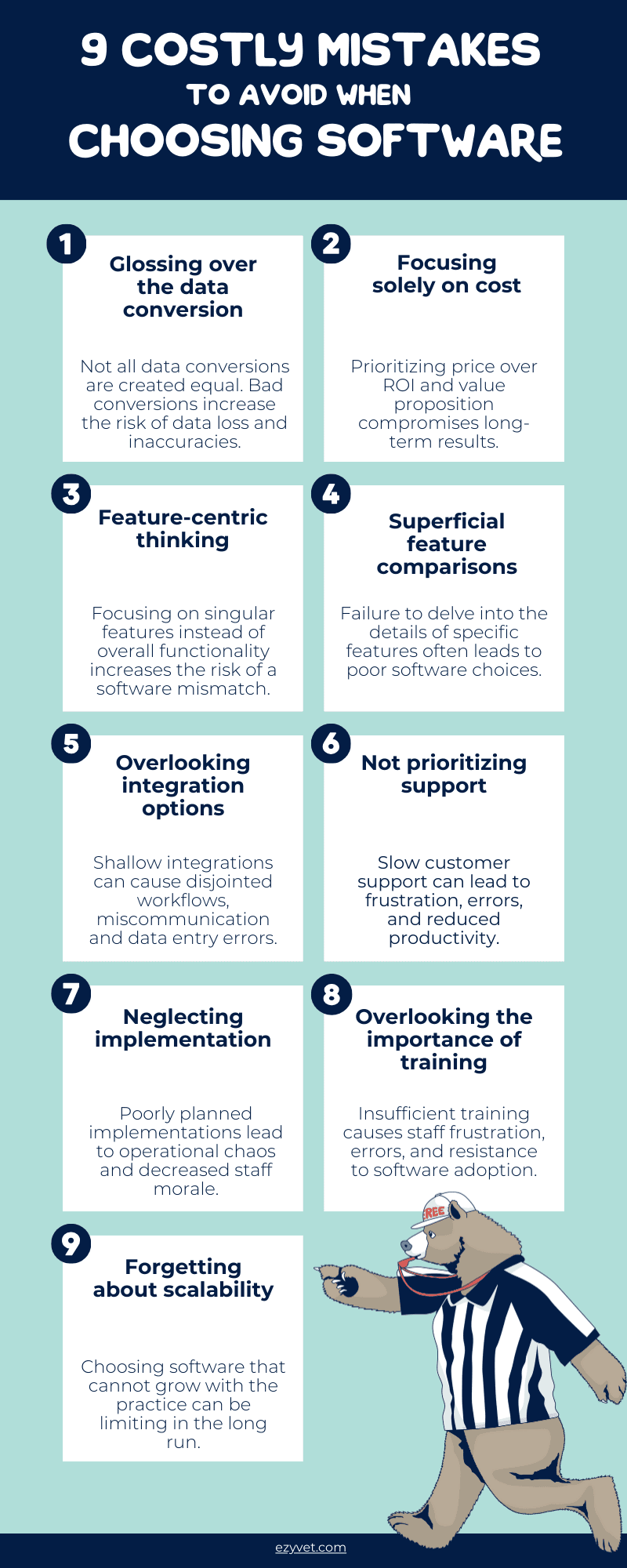
Let’s start by stating the obvious: The right practice management software makes it easier to run a successful veterinary practice.
And the inverse is also true. The wrong software makes it harder.
This doesn’t mean you can’t run a business with the wrong software. You can - it’s just more difficult, less efficient and, ultimately, less profitable.
Of course, nobody sets out to intentionally buy the wrong software. It just happens. Usually because they look for the wrong things during the decision-making process.
Don’t want to fall into the same trap? We’ve got you covered. Here are the top nine mistakes to avoid when choosing practice management software.
Mistake #1: Glossing over the data conversion process
When you transition from one practice management software to another, your historical data needs to be converted to be compatible with your new system. It’s a complex process with no room for error. Get it wrong and there’s a significant risk that data could be lost, corrupted, or otherwise rendered unusable.
Now, every practice management software provider on the planet will convert your data prior to system migration.
But here’s the thing: Not all data conversions are created equal. In some cases, there may be holes in the data. There might be inaccuracies or duplicates. We’ve seen patient histories converted to plain PDF files and imported into the practice’s new system where they couldn’t be used in any meaningful way beyond staff manually reading the document.
This isn’t a theoretical risk. We’ve seen it happen many, many times. Check out this recent case study and see how a botched data conversion compromised the patient records of a Dallas-based practice - and how ezyVet was able to salvage the data.
The key takeaway here is to ask your prospective software provider what the conversion process actually involves:
- How is the integrity of the data verified?
- Is the data checked prior to go-live day?
- What will your data look like at the end of it all?
Mistake #2: Focusing solely on cost
No matter the size of your practice or the revenue you’re bringing in, cost is always going to be a significant factor in the decision-making process.
But it shouldn’t be the only factor.
While a bargain product might seem like a good way to protect the bottom line in the short term, focusing solely on price can lead to overlooking crucial functionality and long-term benefits. You might end up with software that lacks future-proof features, support, or scalability, which might cost you a whole lot more in the long run.
In fact, we’d say that cost-based purchase decisions are the single most common reason veterinary practices end up with the wrong software.
Instead of honing in on the upfront cost, look at the return on investment of the software in terms of improved efficiency, productivity, and patient care outcomes. Sure, Software A might have a higher upfront cost than Software B, but its automation capabilities might save you two hours of work per day. Over a year, that could add up to saving hundreds of hours and tens of thousands of dollars in labor expenses, which would far outweigh any initial price difference.
Take Red Bank Veterinary Hospital as an example. The New Jersey-based hospital was able to save more than 40 hours per week and $100,000 per year on confirmation calls alone after moving to a practice management system with automated text messaging capabilities.
So, don’t get sucked into just looking at the sticker price. Take a holistic approach to evaluating the total cost of ownership of the software. Consider the value proposition of each product based on its ability to meet your specific needs and deliver long-term benefits.
Mistake #3: Feature-centric thinking
Lots of veterinary practices choose the wrong software because they get fixated on a single flashy feature that the vendor has wrapped up in some marketing glitz and packaged as a practice management panacea.
Recent examples might include things like artificial intelligence, machine learning, chatbots, and so on.
We’re not disparaging these innovations; they’re all legitimate game-changers and really can add value to your veterinary practice in all sorts of amazing ways. But none of them, as a singular feature, should be the sole reason you decide to go with one practice management software over another.
Don't let one shiny feature distract you from the bigger picture. Avoid the pitfalls of feature-centric thinking by taking the time to understand a feature’s relevance, usability, and where it fits into your existing workflows. Always take a holistic approach to evaluating practice management software and consider how a product’s overall functionality aligns with your workflow requirements.
Mistake #4: Making superficial feature comparisons
A quick Google search will reveal dozens of practice management software options on the market. Every single one of those products is a bafflingly complex piece of software, complete with its own features. And every single one of those features is implemented in its own unique way.
This makes it a nightmare to compare features objectively. It’s not enough to be familiar with a feature on a superficial level because the way the feature works - core functionality, how it interacts with the rest of the system, customization options, etc. - is different in every software. Yes, both Software A and Software B might ship with an electronic whiteboard, but what does it do? How does the whiteboard interact with the other parts of your software? Can you customize it? Is it regularly updated?
There’s no easy fix for this one - it just takes a lot of homework.
Don’t treat features like a shopping list. Familiarize yourself with any prospective software through demonstrations and hands-on experience. Ask lots of questions. Seek clarification.
If there are specific processes or workflows that are particularly important to you, ask to see them in action.
Mistake #5: Overlooking integration options
If we had to guess, we’d say you probably have at least half a dozen different tools and systems you need to run your veterinary practice. That includes things like your lab equipment, controlled drug cabinets, accounting software, payment processing service, etc.
Go ahead, count them up. If you have a medium or large practice, you’ll likely have substantially more than half a dozen.
When the time comes to select practice management software, you’ll want to choose a solution that integrates with most of those business tools. A robust integration ecosystem allows data to flow freely between your existing systems, helping you save time on manual data entry and reconciliation and minimizing the risk of manual input errors.
On the other hand, failure to prioritize integration can result in disjointed workflows, duplicate data entry, and communication breakdowns between different systems.
Keep in mind that integration functionality can vary significantly depending on how it's implemented. Ask prospective vendors about how specific integrations work, how deeply they’re integrated into the practice management software, and whether there are additional fees involved.
Mistake #6: Not prioritizing support
When it comes to buying new practice management software, customer support is sometimes viewed as a bit of an afterthought in the decision-making process.
That’s a mistake.
In the fast-paced world of veterinary medicine, you need quick, accurate responses. There isn’t time for rambling email chains or lengthy back-and-forths with pesky chatbots. Patients are waiting and you need answers - now.
Comprehensive support and training are essential for ensuring the successful implementation and adoption of new practice management software. Neglecting to prioritize support and training can result in staff struggling to utilize the software effectively, leading to frustration, errors, and decreased productivity.
So, when you’re shopping around for new practice management software, be sure to assess the responsiveness and expertise of the vendor's support team. You’ll also want to consider the quality of support documentation, online resources, and user communities available for the software.
Below are some questions to get started:
- Are your support teams in-house or do you use a third-party provider?
- What support channels are on offer?
- Are support services free?
- Is there a phone line you can call?
- Do you offer 24-hour support?
Mistake #7: Not understanding the implementation process
One critical blunder veterinary practices make when choosing new software is failing to understand the nuances of the implementation.
That’s a problem because the success of the transition hinges heavily on the vendor’s implementation process - and what that process involves varies significantly between providers.
Some might just install the software remotely and throw you in the deep end. Others will give you the white-glove treatment, guiding you through the initial kick-off and project planning stages right the way through to configuring your software and delivering on-site training.
Obviously, this can result in very different experiences, so it’s important to have a good understanding of what the implementation process actually involves when weighing up your options. Ask about the timeline, resources required, and the level of support available before, during, and after implementation.
Mistake #8: Overlooking the importance of training
Every practice management system comes with a learning curve. The steepness of that curve is largely defined by the quality of training that the vendor provides in the lead-up to the migration.
Unfortunately, time and time again we see veterinary practices overlook the importance of training, with staff left scrambling to learn the ropes of the new system on their own. As you might imagine, that can be a confusing and frustrating experience. Staff morale, client satisfaction, and productivity often suffer. Negative perceptions of the new software spread through the practice, which can make staff more resistant to the change.
To ensure a smooth transition, prioritize pre-implementation training. Ask software vendors what the training involves and how it can be tailored to your specific needs and workflows.
- How much training is required to learn the basics of the software?
- Is the training delivered remotely or in person?
- How will training impact your day-to-day operations?
- Will a dedicated trainer be provided to answer your questions?
By investing in pre-implementation training, you can empower your staff to embrace the new software confidently and integrate it into their daily work.
Mistake #9: Neglecting scalability
One of the biggest mistakes practices make is overlooking the scalability of their software. Yes, it’s essential that the software meets your current needs, but it’s equally important to consider how the product will accommodate your future growth. Opt for software that doesn’t scale with your practice and there’s a good chance you’ll need to overhaul your systems again further down the track.
Gaze into your crystal ball. What will your practice look like in one year? Five years? 10 years?
More staff, more clients, more patients, more revenue, additional equipment, extra services, a bigger building, additional sites - whatever your future looks like, it’s important that your software can keep up as your practice evolves.
Look for scalable software that will allow you to expand your operations, add new users, and integrate additional functionalities as your needs change over time.

Takeaway
Choosing the right veterinary practice management software requires careful consideration, research, and planning.
Remember, investing in the right software is an investment in the future success and efficiency of your practice. Take the time to evaluate your options, involve key stakeholders in the decision-making process, and choose wisely.
Good luck!